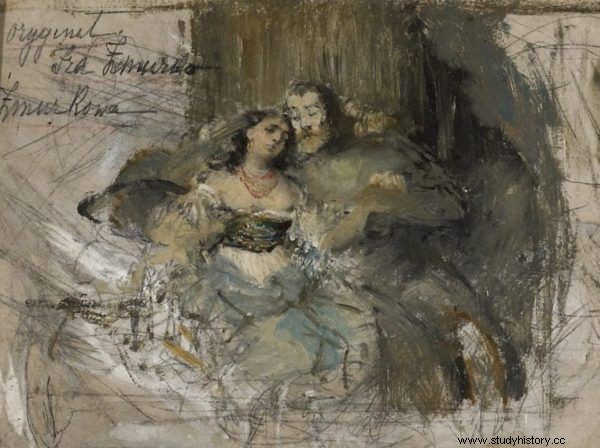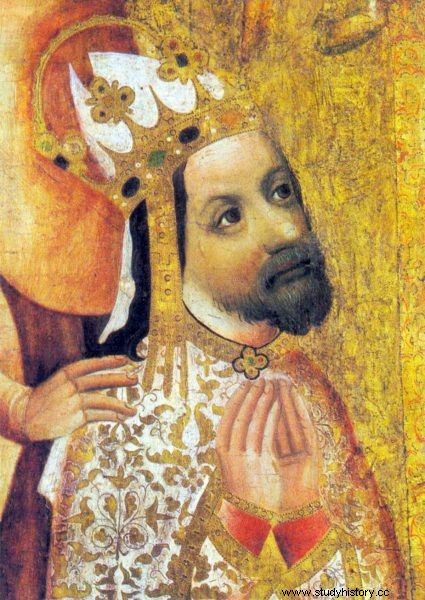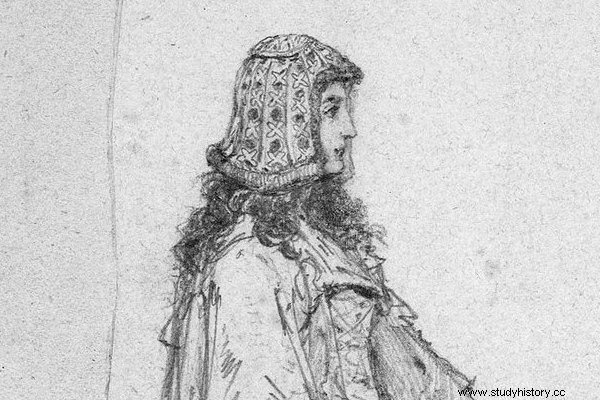It was the year 1356. Casimir the Great expelled his wife, Adelaide Heska, and decided to enter into a new relationship. The ceremony was not grand. Hundreds of guests were not invited, and no games for the public were organized. The king was married almost in secret. Nothing unusual. Marriage was degrading, sinful and illegal.
Never before has a Polish monarch marry a woman from outside his state. Not a princess or a princess, not an aristocrat, but ... an ordinary townswoman. He himself was convinced that he was entering into a relationship with the Prague girl Krystyna Rokiczana out of love. The reality was different. An alluring mistress was offered to him by the King of Bohemia and Emperor Charles IV of Luxembourg. And Krystyna was in fact an agent of hostile interests.
I have already written about the backstage of this ridiculous relationship in another article (click to read it). The king and the townswoman met in Prague during Kazimierz's visit to his southern neighbor. They were going to Krakow together, but Krystyna was firm. She stated that she would live with the monarch only if he dismissed his wife and married her. That is why Kazimierz, who has been trying to get rid of infertile Adelaide for years, finally broke up with his wife and proposed to a new partner.

Casimir the Great according to the pattern of Tytus Maleszewski. Lithograph from the second half of the 19th century.
The wedding took place almost immediately. The sacrament was administered not even by any bishop, but by the Abbot of Tyniec. A man devoted to the monarch, but still fully aware that he blesses a union that is utterly unworthy and illegal. After all, Kazimierz's earlier marriage was not annulled by the Church.
Medieval punishments for bigamy
If Kazimierz were not the king, and he lived somewhere in Western Europe, he could even be castrated or cut off his arm for the act he had committed. This was the case with bigamists, for example, in northern Italy. In much closer to Wrocław, polygons were beheaded as if they were murderers. In Krakow, the courts were also not very understanding. For example, the local 14th-century case of a bigamer who was publicly flogged, banished from the city, and his hideous act ordered to be announced through heralds to all the inhabitants of the capital is known.

Casimir the Great with one of his lovers in the painting by Franciszek Żmurka (late 19th century).
The king's double marriage also had to be in the tongues of the entire city. Kazimierz could not, however, be punished by councilors or even bishops. There was only one instance - the Pope. And it was to him that the dismissed and humiliated immediately turned to the king's wife, Adelaide. From 1357 onwards, she complained not only about abandonment and exile, but also about the king's new, perfidious relationship.
She explicitly demanded that "the marriage, and in fact cohabitation with Rokiczana, and the entire resulting relationship, concluded in a vain and audacious manner between the aforementioned king and Krystyna, a Prague bourgeois, be annulled and that the said king be forced by all legal means to remove her and expel her from country ”.
Kazimierz must have expected that not for the first time, but more than ever, he would be at stake with the Holy Father. He probably hoped that the Czechs would reach out to him and help legalize the relationship with the woman they had narrated to him. It can be guessed that it was the belief in the support of the emperor that prompted the monarch to conclude a bigamic relationship. Kazimierz broke church regulations because he was convinced that no punishment would hit him.
Charles IV. Extremely Helpful Neighbor
Emperor Charles IV of Luxembourg did not in fact remain idle. He complied with a neighbor's request and did not support Adelaide's petition. At the same time, however, sudden scruples aroused in him and he began to convince Kazimierz that ... he wanted to bring agreement between spouses who were divided.
Unexpectedly, after fifteen years of the Polish king's marriage, he stated that it was not acceptable that the dowry should not be paid for his wife. It should be remembered that Adelaide's marriage to Kazimierz was also mediated by the Czechs and especially by Charles himself, who was heir to the throne at the time. The relationship not only turned out to be extremely unsuccessful, but also extremely unprofitable. The bride's father, Henryk Żelazny, who ruled Hesse, never paid the promised dowry. The Czechs did not mind. Until 1357.

Charles IV of Luxembourg
Only now in Charles IV did his conscience unexpectedly awaken. He concluded that if Henry Żelazny did not pay his obligations, then the emperor - who is his sovereign after all - would do it personally.
The act of grace was not accidental. The lawyers advising Kazimierz saw perhaps the only chance to legally get rid of Adelaide in the absence of a dowry. If the wedding was not properly paid, then the queen was not entitled to any goods and income in Poland. She could be deprived of her salary and lifelong fixture in the form of the Sandomierz Land. Or at least… it could be done as long as the Luxembourgs didn't get involved. Now everything seemed to be bogged down in church courts for years to come.
The King's Wife or a plug from a rival bloodline?
The winner was, of course, Charles. Developments in either direction served his interests. He kept the king in check in the curia, but also - he followed all his actions and exerted a strong influence on them. After all, he installed his own reliable agent at Wawel.

Casimir the Great at the famous feast at Wierzynek's. Mid-19th century lithograph.
Krystyna Rokiczańska understood perfectly well to whom she owes her fabulous promotion and to whom she owes absolute loyalty. Already from her new residence and as a royal wife, she secretly sent letters to the Bohemian king. One of them has acted and reveals the real backstage of a shocking marriage.
Krystyna assures her principal that she remembers that she "stays in Poland thanks to him". He emphasizes that Karol "can trust her as if she were still in the city of Prague". In a word:Rokiczana was at his beck and call. And he was not afraid to use the influence he exerted on the woman.
The legacy of Krystyna Rokiczany
Krystyna was constantly at the king's side. She accompanied him on his travels, interfered in his decisions, distracted him from pressing problems that could adversely affect the interests of Luxembourgs. It paralyzed the actions of Kazimierz for several long years.

Adelajda Heska on a sketch by Jan Matejko.
She was definitely not his only partner at the time. Perhaps the monarch also established a relationship with a certain Estera during his relationship with Rokiczana. An affair with a beautiful Jewish woman has become legendary, although it is difficult to prove that it actually happened. Even if Esther did not exist, other lovers must have appeared. And the influence of Krystyna, who was gradually getting bored by Kazimierz, began to weaken inexorably. It didn't matter anymore.
The king was a bigamist, his relations with the papal curia were in the gutter, and his relationship with Rokiczana, as illegal and morganatic (concluded outside the state), could not bring a recognized heir to the throne. Due to his naivety and susceptibility to female charms, Kazimierz questioned the future of the entire dynasty.
Selected bibliography:
The article was based on materials collected by the author during the work on the book "Ladies of the Polish Empire. The Women Who Built a Power " . Some of these items are shown below. Full bibliography in the book.
- Kiryk F., The Great King and His Successor , National Publishing Agency 1992.
- Klápště J., The Czech Lands in Medieval Transformation , Brill, Leiden – Boston 2012.
- Kurtyka J., The reborn kingdom. The monarchy of Władysław Łokietek and Casimir the Great in the light of more recent research , Societas Vistulana, Krakow 2001.
- Wyrozumski J., Casimir the Great , Ossolineum, Wrocław 2004.
- Śliwiński B., Chronicle indiscretions, or the private life of the Piasts , Marpress, Gdańsk 2004.
- Śliwiński J., The marriages of Casimir the Great. A study in the field of morality and ethics of the royal court in Poland in the 14th century , Pedagogical University in Olsztyn, Olsztyn 1987.
- Świeżawski E.S., Esterka and other women of Casimir the Great [in:] the same, Outlines of critical research on history, historiography and mythology , vol. 3, Warsaw 1894.
